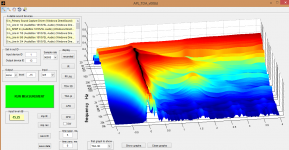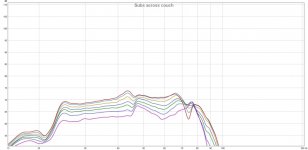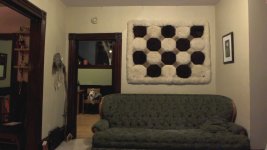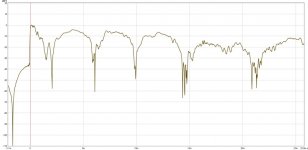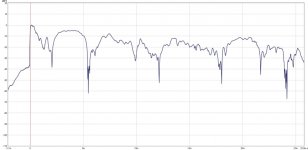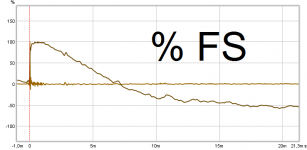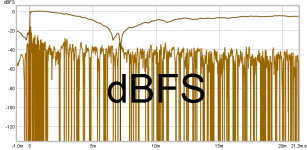John Murphy argues that slow bass = late bass. Group delay is the cause of the illusion of slow bass.
https://www.trueaudio.com/post_010.htm
https://www.trueaudio.com/post_011.htm
I agree...
Ok, now I think I understand what you mean by fast bass. You mean room resonances are minimized at your listening spot and that the bass frequencies arrive at the same time as the rest of the frequencies. Ok, that is good, no doubt about it. Although, the lack of room resonances is far more important.
The FR chart shows a spread of 5-6 db at about 45 Hz and about 7-8 db spread near 60 Hz. This is normal for any room. There is nothing special that the arrays are doing here. A pair of arrays is no different than a pair of subs. In fact, having separate subs provides more freedom in placement and in dealing with room modes. Having 3 or 4 is even better (more freedom and choices to deal with room modes) but it gets complicated too.
If you measure in one spot and correct, it will only provide the best correction in that spot, at least for bass frequencies where modes are active. If you average across the couch and EQ, the correction will not be optimum for any single spot but will be somewhat ok across the couch. You pick your poison and you live with it.
Believe me that I am not trying to downplay your efforts. You know I'm a fan. And I have arrays too. I was just trying to dispel this notion of slow or fast bass, which is often mistaken for too much or too little bass. You are talking about something else, about bass having meaning and is in keeping with the rest of the music.
The FR chart shows a spread of 5-6 db at about 45 Hz and about 7-8 db spread near 60 Hz. This is normal for any room. There is nothing special that the arrays are doing here. A pair of arrays is no different than a pair of subs. In fact, having separate subs provides more freedom in placement and in dealing with room modes. Having 3 or 4 is even better (more freedom and choices to deal with room modes) but it gets complicated too.
If you measure in one spot and correct, it will only provide the best correction in that spot, at least for bass frequencies where modes are active. If you average across the couch and EQ, the correction will not be optimum for any single spot but will be somewhat ok across the couch. You pick your poison and you live with it.
Believe me that I am not trying to downplay your efforts. You know I'm a fan. And I have arrays too. I was just trying to dispel this notion of slow or fast bass, which is often mistaken for too much or too little bass. You are talking about something else, about bass having meaning and is in keeping with the rest of the music.
I measure and correct in one spot. But use the info I got from the couch sweep to judge it. Guess what? The average of it is in line with the set output in the measurement position. So that makes it plus/minus 4 dB max deviation over the listening area.
I've seen way worse performances. I have/use no bass traps. This couch measurement was my test to see if I needed to use multiple measurement positions or if I could stick to just one in the sweet spot.
Please show me the same data made with 2 subs, both subs playing, in the sweet spot and 30 cm to the left, 60 cm to the left, 90 cm to the left, 30 cm to the right, 60 cm to the right and 90 cm to the right. Seriously, I'd like to see it. It will be good data to know if I can add subs to my arrays. If they stay within 4 dB of the sweet spot measurement in average it will be as good as my arrays. I'd really be interested in seeing that.
A stereo measurement every 30 cm is going to deviate in mid and high frequencies by the ever changing distance to left and right speaker though. But I'd recommend this test to anyone serious enough to know/learn what they got out in the room. It's speaker + room that really matters.
We have had that "fast bass" discussion on this thread before. A 50 Hz note is just that... but many people have way too much overhang and/or group delay at bass frequencies. Still they try to judge about fast and slow bass out in that room.
I am convinced time coherency matters, by feeling the bass as well as hearing it. The feel part is as important as the listening. If you have output that low to really feel it.
Take a kick drum. The force, or power is between ~30 and 50 Hz. If that's loud enough you'd be able to feel it in your stomach(*). The kick happens between 80 Hz and 160 Hz Many love the kick in the chest, that's where you'll find it. That's mid bass territory. The slam/slap will be even higher
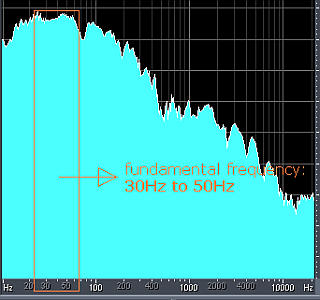
If you get it right it really feels like you're in front of it. If you play it at loud enough SPL it's awesome.
Run that APL demo, look at what it shows you. It's way more telling than any graph from REW to really show what's happening out in that room.
(*) that part will never sound fast on it's own. Take away the top end and it's sounding slow. Have the upper parts arrive in time and it sounds "real".
P.S. just looked up that couch sweep, it's a 6 dB deviation at 60 Hz with 1/12 dB/octave smoothing, the setting that is shown in the graph. at 1/48 smoothing it's a 7 dB difference between the loudest peak and the biggest dip. The average value is right in the middle and lines up with the sweet spot target. Anyone with a 2 sub setup that wants to show what it does?
I've seen way worse performances. I have/use no bass traps. This couch measurement was my test to see if I needed to use multiple measurement positions or if I could stick to just one in the sweet spot.
Please show me the same data made with 2 subs, both subs playing, in the sweet spot and 30 cm to the left, 60 cm to the left, 90 cm to the left, 30 cm to the right, 60 cm to the right and 90 cm to the right. Seriously, I'd like to see it. It will be good data to know if I can add subs to my arrays. If they stay within 4 dB of the sweet spot measurement in average it will be as good as my arrays. I'd really be interested in seeing that.
A stereo measurement every 30 cm is going to deviate in mid and high frequencies by the ever changing distance to left and right speaker though. But I'd recommend this test to anyone serious enough to know/learn what they got out in the room. It's speaker + room that really matters.
We have had that "fast bass" discussion on this thread before. A 50 Hz note is just that... but many people have way too much overhang and/or group delay at bass frequencies. Still they try to judge about fast and slow bass out in that room.
I am convinced time coherency matters, by feeling the bass as well as hearing it. The feel part is as important as the listening. If you have output that low to really feel it.
Take a kick drum. The force, or power is between ~30 and 50 Hz. If that's loud enough you'd be able to feel it in your stomach(*). The kick happens between 80 Hz and 160 Hz Many love the kick in the chest, that's where you'll find it. That's mid bass territory. The slam/slap will be even higher

If you get it right it really feels like you're in front of it. If you play it at loud enough SPL it's awesome.
Run that APL demo, look at what it shows you. It's way more telling than any graph from REW to really show what's happening out in that room.
(*) that part will never sound fast on it's own. Take away the top end and it's sounding slow. Have the upper parts arrive in time and it sounds "real".
P.S. just looked up that couch sweep, it's a 6 dB deviation at 60 Hz with 1/12 dB/octave smoothing, the setting that is shown in the graph. at 1/48 smoothing it's a 7 dB difference between the loudest peak and the biggest dip. The average value is right in the middle and lines up with the sweet spot target. Anyone with a 2 sub setup that wants to show what it does?
Last edited:
One thing I've learned about single location measurements (at least with my system) is that when you extract the minimum phase portion and then apply a frequency dependent window, the response is similar to that of the smoothed multi-position (averaged) measurement. It seems like maybe excess phase response is more position dependent than the minimum phase response and therefore gets cancelled out by the averaging process to a higher degree. If that's true, it could be part of why we need to keep EP correction to a minimum. I think this graph shows that for MP correction (and perhaps when applying a touch of EP correction as well), a single measurement is adequate. Also, it's nice to not have to compromise the response at the sweetspot.
Attachments
If I have to guess, my bass is more even now than when I took that couch measurement. One day I may get the mic out again and redo it but I'm not in a hurry. It's even throughout the listening position and I do attribute that to the arrays way of loading the room. Anyone wondering the plot has a 5 dB vertical scale.
As said, I'd love to see real life results from 2 subs between 20 and ~80 Hz.
As said, I'd love to see real life results from 2 subs between 20 and ~80 Hz.
I guess you could write a book on speaker/room correction at this point
At least a small article on how/where to start with interpreting the measurements and applying correction would be very helpful. I know that you've posted a lot of useful info but it's scattered all over the place.
And share all my secrets? Oh, wait... too late! I already did that
One thing I've learned about single location measurements (at least with my system) is that when you extract the minimum phase portion and then apply a frequency dependent window, the response is similar to that of the smoothed multi-position (averaged) measurement. It seems like maybe excess phase response is more position dependent than the minimum phase response and therefore gets cancelled out by the averaging process to a higher degree. If that's true, it could be part of why we need to keep EP correction to a minimum. I think this graph shows that for MP correction (and perhaps when applying a touch of EP correction as well), a single measurement is adequate. Also, it's nice to not have to compromise the response at the sweetspot.
That's why I don't think it's a good idea to fix phase at the listening spot with a tool like RePhase and call that time coherency. Even though it will give you a nice STEP response at that single position. Without even filtering the data!
I dug deep into REW to find the cause of each phase swing, and only correct those that are there, right from the start of the wave front. That took a lot of work looking at slices of the IR to find out what was going on on several of REW's tabs. Frequency dependent windows weren't part of REW at that time.
That FDW tool sure makes it easier as does a tool like APL_TDA.
The other deviations that start a little later are probably caused by something out in the room.
The point is: I made sure to only try and fix what I believe was fixable.
That didn't include my corner trouble in the left array at 60 Hz for instance.
I take energy away at that dip, not add more trouble.
I also left the little stuff between 120 and 200 Hz in my right array unfixed, phase wise. Though I did manage to improve my right channel response recently with basic IIR PEQ's.
One can only fix those errors that stay similar or the same if measured off axis.
Honestly, I would also like to see those results. I haven't had a chance to measure in quite some time. I want to update the measurements in my own thread as well. I'll try to squeeze some time during the holidays to measure subs across the couch. One can get a pretty good idea of what is happening by using REW's room simulator. The acoustics at bass frequencies are pretty much determined by the room and any room sim program will be very accurate if you can get your room's design in it. What you measure in the steady state is what you will hear.
Artsy,
I'm sure I could do something in the range of the ScanSpeak driver. I would be using the best Neo material, MgOe 55H or there about, with a cast frame and American made voice-coils. I would make the composite cone myself and get a special surround made for that kind of excursion. I'll have to play with the cone to get it just right for this application.
I keep thinking if you designed the driver correctly you could make the center dust cap into a 1" dome tweeter so it would be a tiny coaxial driver, just an idea. If I did this I wouldn't do it without Ronald, no way. First thing would be to send Ronald a set of drivers for his cabinets and see what he thinks. If I can't improve on what he has now I wouldn't continue the project.
I have thought about the use of a coaxial instead of a full range driver, but it would create new problems of it's own. Plus a coaxial would need a cross over.
The moving wave guide the tweeter would get isn't ideal. Especially since we want to be able to use that x-max. It's surprising though how little my cones move, even on some serious bass notes. The numbers really help share the load.
I'm not sure how much of a full range cone actually plays (moves) at high frequencies. The bigger this area is, the better.
The way the TC9 transitions to the HF part is quite smooth. The 10F is even smoother, still. The clean IR of both are good indicators of this. No ringing top end, the rise at high frequencies is welcome, as long as it's smooth.
To have more usable x-max probably needs a clever surround to not create too much diffraction right there.
Last edited:
I just tested an APL plot on my little TABAQs in a room I thought was not so bad, having bass traps and some absorption panels....
It was not pretty.... well, not pretty like yours!
Ok, I think I'm starting to get it.
So, maybe not so bad after all, this at 5ms though...
Attachments
It does show what's happening, doesn't it? The big reflection at 1.7 ms, a ringing top end in the signal (could be from playing at 96000), I don't know what happens in the bass, I assume it's a ported enclosure? But what is the port's design frequency?
Could we see a picture showing more ms? Say 30 ms?
Could we see a picture showing more ms? Say 30 ms?
Two subs at my listening area:
Interesting measurement, not sure if this one is going to encourage You.
Red line is 3 feet left of the sweet spot (Corner)
Blue line is the Sweet Spot
Violet line is 3 feet right of the sweet spot (doorway)
Measurements where taken at 1 foot increments.
I have two subs running off one output, so they are not independently EQed. Also, the back wall that influences my listening area is not symmetrical. One side is a corner and the other side is a door. I do not think room treatments can fix that at these frequencies. Needless to say, in my room, if You like bass, sit on the left with the corner, if not, stand in the door.
If I was not enjoying my sound so much, drawing Christmas card designs in the sweet spot, I could go in the basement and bring up the door, hang it, close it, and remeasure.
Yes, the room is indeed VERY influental.
Interesting measurement, not sure if this one is going to encourage You.
Red line is 3 feet left of the sweet spot (Corner)
Blue line is the Sweet Spot
Violet line is 3 feet right of the sweet spot (doorway)
Measurements where taken at 1 foot increments.
I have two subs running off one output, so they are not independently EQed. Also, the back wall that influences my listening area is not symmetrical. One side is a corner and the other side is a door. I do not think room treatments can fix that at these frequencies. Needless to say, in my room, if You like bass, sit on the left with the corner, if not, stand in the door.
If I was not enjoying my sound so much, drawing Christmas card designs in the sweet spot, I could go in the basement and bring up the door, hang it, close it, and remeasure.
Yes, the room is indeed VERY influental.
Attachments
Last edited:
These look out right nasty compared to yours, but we got to start somewhere.
To look same as wesayso SR graphs can you up in graphs area at left corner switch as seen below and repost.
Attachments
Hi CraigSu,
Yes... an innocent question. I'd go for sealed subs for their better time response. A port would always be firing 180 degree out of phase. OB would be an option, but way bigger.
If I steal the picture from BYRTT which he took while visiting:
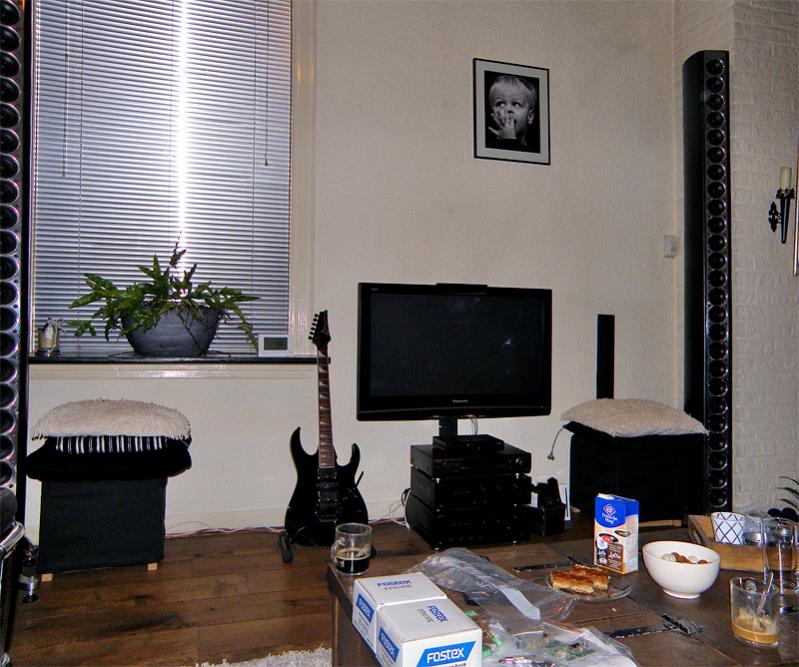
You'll notice the 2 black boxes with cushions. They are feet bench that my girlfriend bought a long time ago and secretively I've measured them to see what I could fit inside of it. It could hold a 12" sealed subwoofer, and I would use a Linkwitz transform on them to get what I need out of it.
Hi Ron,
Your photo and post got me thinking about you putting some sealed subs in your set up....
Looking into this – IMO it seems you would benefit from a couple stereo subs, and actually looking at some preliminary maths you might be able to put a nice pair of black sealed subs in exactly the same spots your current boxes sit – I don’t think they need to be much bigger either to get significant bass gains!
If we do some maths:
Single Vifa TC9 = 37cm2 SD (from data sheet)
So, 50 vifas x 37cm2 = 1850cm2 total SD roughly the same as 2 x 18” woofers.
But only 3mm x-max
So VD (x-max x SD) for the 50 x Vifas = 5550 cm3 volume displacement to move air.
If we compare this to a fairly good, but standard 10” subwoofer, the peerless 10” XXLS:
PEERLESS 835016 XXLS = 356.3cm2 SD (from data sheet)
2 x 10” subs x 356.3 = 712.6cm2 total SD
However 12.3mm x-max
So VD for two stereo 10” subs = 8765 cm3 volume displacement to move air.
So using a SpL calculator,
The Vifa line arrays, in a sealed configuration:
1850cm2 SD with x-max 3mm can output 92 dB at 1M at 17 hz.
At a listening distance of 3M this pressure level will drop to roughly 82 dB at full x-max.
When you take Fletcher–Munson curves into account 82 dB at 17hz doesn’t seem to be loud enough to be very audible at the listening position.
Just looking at the maths above, IMO it would seem that you could benefit from some stereo subs because 2x10” ones will give you a substantial increase in displacement - almost 60%, let alone a couple 12” or 15” subs!
It does show what's happening, doesn't it? The big reflection at 1.7 ms, a ringing top end in the signal (could be from playing at 96000), I don't know what happens in the bass, I assume it's a ported enclosure? But what is the port's design frequency?
Could we see a picture showing more ms? Say 30 ms?
Next set of measurements will be on the weekend, as the room is used for students to do their homework on weekdays.
The reflection at 1.7ms is a table. I had another table, a tad closer to the mic and there was a strong reflection at about 1.5ms. I moved that table away, and the reflections dropped to what you see now. Unfortunately, I couldn't move away the second table.
Those measurements were taken from a pair of TABAQs, port is tuned at 45Hz, if I remember correctly.
I took a 30ms sample, but it just looked like some stratocumulus in there...
Hi Ron,
Your photo and post got me thinking about you putting some sealed subs in your set up....
Looking into this – IMO it seems you would benefit from a couple stereo subs, and actually looking at some preliminary maths you might be able to put a nice pair of black sealed subs in exactly the same spots your current boxes sit – I don’t think they need to be much bigger either to get significant bass gains!
If we do some maths:
Single Vifa TC9 = 37cm2 SD (from data sheet)
So, 50 vifas x 37cm2 = 1850cm2 total SD roughly the same as 2 x 18” woofers.
But only 3mm x-max
So VD (x-max x SD) for the 50 x Vifas = 5550 cm3 volume displacement to move air.
If we compare this to a fairly good, but standard 10” subwoofer, the peerless 10” XXLS:
PEERLESS 835016 XXLS = 356.3cm2 SD (from data sheet)
2 x 10” subs x 356.3 = 712.6cm2 total SD
However 12.3mm x-max
So VD for two stereo 10” subs = 8765 cm3 volume displacement to move air.
So using a SpL calculator,
The Vifa line arrays, in a sealed configuration:
1850cm2 SD with x-max 3mm can output 92 dB at 1M at 17 hz.
At a listening distance of 3M this pressure level will drop to roughly 82 dB at full x-max.
When you take Fletcher–Munson curves into account 82 dB at 17hz doesn’t seem to be loud enough to be very audible at the listening position.
Just looking at the maths above, IMO it would seem that you could benefit from some stereo subs because 2x10” ones will give you a substantial increase in displacement - almost 60%, let alone a couple 12” or 15” subs!
Sorry - just to correct my own shocking maths:
So VD (x-max x SD) for the 50 x Vifas = 5550 cm3 volume displacement to move air.
Should say - 555cm3 VD
So VD for two stereo 10” subs = 8765 cm3 volume displacement to move air.
Should say - 876.5cm3 VD
The SPL and other calculations are OK.
...The SPL and other calculations are OK.
Hi bushmeister am i right in line array have special formula to loose less SPL per meter listening distance compared to normal point source and if yes was that formula into your calculations
Hi bushmeister am i right in line array have special formula to loose less SPL per meter listening distance compared to normal point source and if yes was that formula into your calculations.
Very good question Byrtt!
At 17 hz the wavelength of sound is 20 metres - so I would have thought the line array would sum as a single source - i.e. similar to a single driver.
I think an array has to be over 1.5x the wavelength in a given dimension to affect directivity, and therefore SPL drop over distance would be the same as for a single large woofer.
However, I hope someone more learned will chime in if I am wrong.
Even if wesayso's arrays are directional and therefore acting as line arrays in the sub bass - the max SPL at the listening position would still be significantly better with a couple high displacement 10 or 12" dedicated subs (you can even place them nearfield - i.e. directly behind the couch as I do and avoid any SPL drop at all!)
But even better - he could run the subs with the arrays at the same time - just not boosting the bass as much on the arrays and hopefully achieve the same magic with HT bass levels!
I guess the point I am making is that while the arrays have a pretty good SD, their x-max is very small at 3mm for sub-bass reproduction - so bass will suffer at high SPL - that is just physics, therefore if you want to watch a movie with THX bass - they may require augmentation.
Just some food for thought.
- Home
- Loudspeakers
- Full Range
- The making of: The Two Towers (a 25 driver Full Range line array)
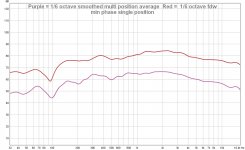
 .
.